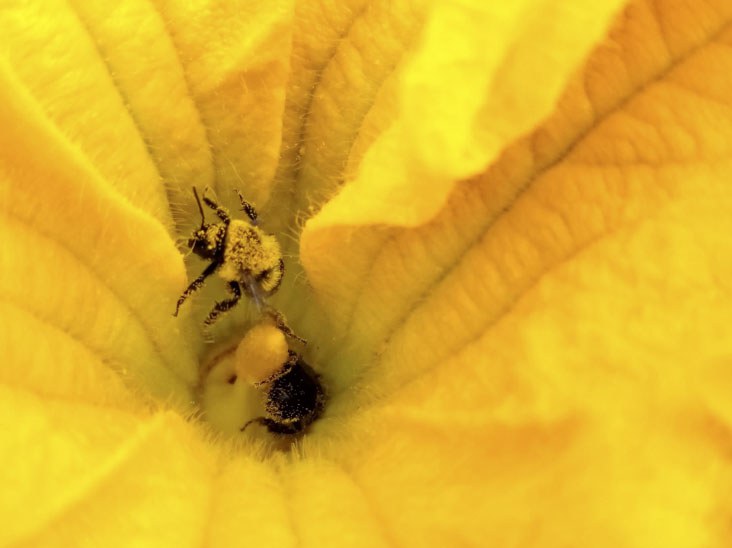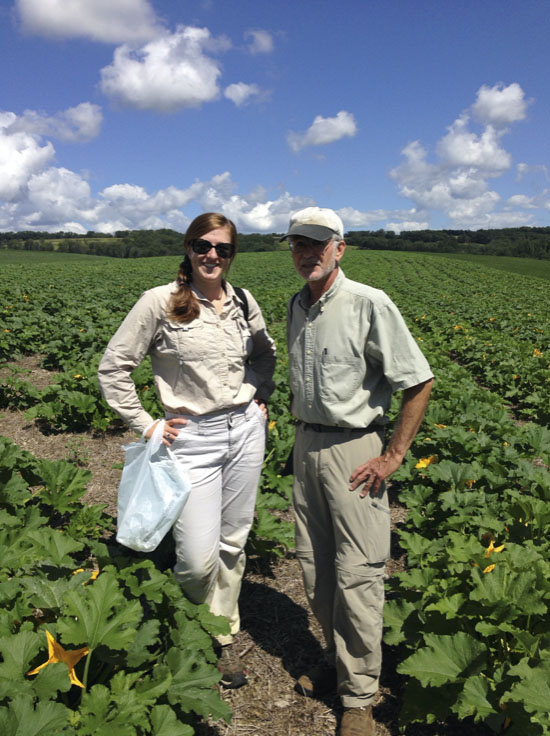Posted: January 24, 2020
Pumpkin growers frequently rent managed honeybee colonies to pollinate their crops, but a recent study published in the Journal of Economic Entomology suggests wild bees may be able to do the job just as well and for free. During a three-year study, researchers at Penn State found that bumble bees and squash bees, alone, could meet the pollination demands for sufficient pumpkin production in wholesale commercial fields in Pennsylvania.
For three summers, the researchers counted the number and types of bees visiting pumpkin flowers in 24 fields. Approximately 97% of their observations consisted of three pollinators: bumble bees, honeybees, and squash bees, which was consistent with previous studies. More surprisingly, however, hand collections from the blossoms revealed 37 different bee species visiting the flowers. Dr. Shelby Fleischer, one of the lead researchers on the pumpkin project, remarked, "We had no idea [pumpkins] provided resources for a much wider community of bees than originally thought, it's exciting."
In addition to field observations and collections, the team used the existing body of literature to develop pollination thresholds for their most frequently spotted bees. In other words, they determined how much pollen a pumpkin flower needs to set fruit successfully and how much of that pollen bees carry on their bodies during each visit. Using the most conservative estimates, both honey and squash bees require about 16 visits to successfully pollinate a pumpkin flower, while bumble bees only need half that amount.
When the researchers multiplied the number of visits recorded by the number of pollen grains each species deposits, they found that wild pollinators easily exceeded the pollination requirements for pumpkins in Pennsylvania by almost 15-times the rate necessary.
These abundant local pollination services are good news for growers' wallets as well. One of the largest growers involved in this research project considered the study's results and halved his honeybee rentals. Fleischer estimates that for this grower's 400 acres of pumpkins, the hive rental reduction saves around $25,000 annually, without any production loss.
So how should growers use managed bees in the future? Fleischer says to think of them as a matter of insurance, "most years in Pennsylvania you won't need to rent honeybees. Especially if you have [pumpkins] in a landscape where squash bees can populate, as well as diverse floral resources and nesting habitats - then you would be in good shape for pollination." Regardless, he emphasized, "that while we have this wild resource that we don't have to pay for, we can't take it for granted and we need to learn how to conserve it."
You can read the paper, Wild Bee Visitation Rates Exceed Pollination Thresholds in Commercial Cucurbita Agroecosystems, online. This study was part of a larger 5-year project known as the Integrated Crop Pollination project ('Project ICP'). Researchers collaborated across institutions throughout the United States to study different pollinator-dependent crops, such as watermelons, tart cherries, almonds, apples and blueberries. Focal crops in the state of Pennsylvania included cherries, apples, and pumpkins. Please visit the Project ICP website for more information about the program.
For more information on pumpkin pollination, please read: Integrated Crop Pollination for Squashes, Pumpkins and Gourds
by Rachel McLaughlin
Dr. Shelby Fleischer and master's student Carley McGrady in a pumpkin field



